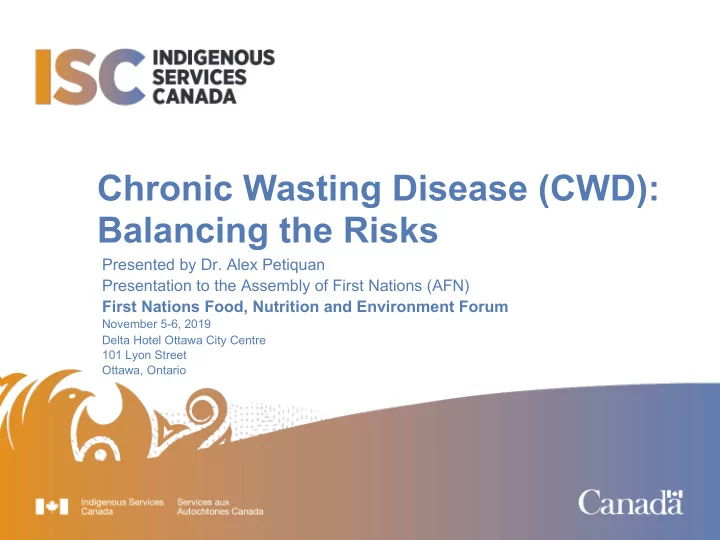

Chronic Wasting Disease (CWD): Balancing the Risks Presented by Dr. Alex Petiquan Presentation to the Assembly of First Nations (AFN) First Nations Food, Nutrition and Environment Forum November 5-6, 2019 Delta Hotel Ottawa City Centre 101 Lyon Street Ottawa, Ontario
• Traditional food has significant nutritional, social, cultural and spiritual value, and is an important part of food security for Indigenous peoples. • If you hunt, handle, or eat traditional foods like deer, elk, caribou, or moose, it is important to know about chronic wasting disease. 2
Table of Contents • Food Insecurity • Key Findings on Traditional Foods • Chronic Wasting Disease (CWD) 3
Food Insecurity Household food insecurity by region, compared to Canada Source: FNFNES Draft Comprehensive Summary Report, 2019 (p.105) 4
Key Findings: Nutrient Intake on Days with Traditional Food • Higher Intakes of: • Lower Intakes of: – Protein – Sugar – Linolenic acid (omega-3) – Saturated fat – Iron – Sodium (salt) – Zinc – Magnesium – Copper – Potassium – Phosphorus – Vitamin D Systemic changes are – Riboflavin needed to address the complex issue of food – Niacin access, diet quality, and – Vitamin B6 associated health – Vitamin B12 problems. Source: FNFNES, 2018 5
What is Chronic Wasting Disease (CWD)? • Chronic wasting disease (CWD) is a disease of the brain and nervous system that affects white-tailed deer, mule deer, moose, elk, red deer, and reindeer. • CWD belongs to the family of diseases known as transmissible spongiform encepholopathies (TSE). • While it shares features with similar diseases that affect cattle and sheep, CWD is only known at this time to naturally affect members of the deer (cervid) family. • CWD is fatal to these animals. 6
Myth and Fact • Myth : People should not eat deer, elk, caribou, or moose meat because of chronic wasting disease. • Fact : Deer, elk, caribou, and moose meat is safe to eat and most body parts are safe to use. 7
Is CWD a risk to human health? • There are no known cases of human CWD. • However, as a precaution, it is recommended that any part of a known CWD-infected animal not be used or consumed by humans • Do not handle or eat any part of an animal that looks sick, has died from unknown causes, or has tested positive for CWD • Always use care in handling the carcass of any animal. 8
What are the signs of CWD in animals? • Animals with CWD may show a number of signs as the disease slowly damages their brain. • Can be very hard to detect. • Signs can last for weeks to months before the animal dies. • Some animals may never show any signs of the disease. 9
What are the signs of CWD in animals? • Signs may include: – Unusual behaviour – Lack of coordination – Listlessness – Trouble swallowing – Drooling – Increased thirst – Paralysis – Pneumonia – Separation from other animals in the herd – Excessive urination – Unusual thinness 10
How is CWD diagnosed? • The only way to confirm that an animal is infected with CWD is to test a body part (usually the brain) after it is dead. • A negative test result does not guarantee that an animal is not infected with CWD, but it does make it considerably less likely and may reduce your risk of exposure 11
How can I reduce the risk? • Before going out to hunt, check with the provincial or territorial wildlife management office where you live or hunt to identify areas where CWD is known to occur. 12
How can I reduce the risk? • Pay attention to the appearance and behaviour of the animals you are hunting. • Do not kill an animal that appears to be sick or acts abnormally. 13
How can I reduce the risk? • Never handle or eat an animal that has died from unknown causes or has tested positive for CWD. 14
How can I reduce the risk? • Avoid handling or eating the animal’s brains, spinal cord, eyes, spleen, tonsils, or lymph nodes; – Normal field dressing together with boning out a carcass will remove most, if not all, of these body parts. Cutting away all fatty tissue will remove remaining lymph nodes . 15
How can I reduce the risk? • When handling the carcass, wear latex or rubber gloves. If you use parts of the carcass to tan the hide, minimize handling of the animal’s head and brain. 16
How can I reduce the risk? • Wash hands and tools thoroughly with soap and water after field dressing is completed. Tools can then be disinfected with bleach . 17
How can I reduce the risk? • Appropriate transportation and disposal is also important to help reduce the spread of CWD. Contact your provincial or territorial wildlife management office for more information on how to transport carcasses and dispose of animal parts you won’t use. 18
How can I reduce the risk? • If the animal carcass is from an area where CWD is known to occur, it is recommended that you have it tested for CWD. Wait for a negative result before any parts of the animal are used or eaten. • The provincial or territorial wildlife management office where you live or hunt can give you information on how to have a carcass tested. Testing may be free of charge in your area. 19
For more information on testing: • Alberta • British Columbia • Manitoba • Northwest Territories • Ontario • Quebec • Saskatchewan • Yukon 20
Related Links • CFIA: Chronic wasting disease (CWD) of deer and elk • Tips on food safety when hunting 21
Recommend
More recommend